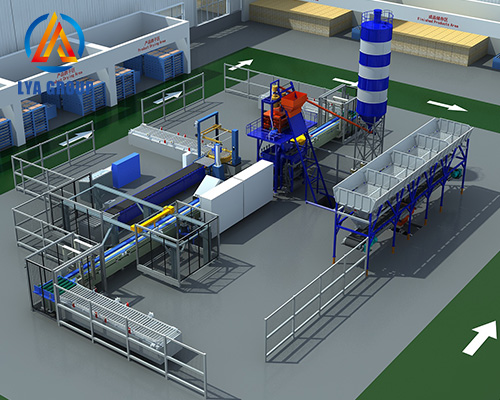Progress of making wet casting products by using production line
News 2024年3月25日 56

Raw Material Preparation: The production line starts with the preparation of the raw materials. The main components typically include cement, aggregates (such as sand, crushed stone, or gravel), water, and additives. The aggregates are carefully selected and processed to achieve the desired size, shape, and texture.
Mixing: The prepared aggregates, cement, water, and additives are mixed together in a concrete mixer. The mixing process ensures that the aggregates are evenly distributed and coated with the cement paste, resulting in a homogeneous mixture.
Molding: The mixed concrete is then poured into molds to create the desired shape and size of the artificial stones. The molds can be made of various materials, such as steel, rubber, or fiberglass, and are designed to replicate the texture and details of natural stones.
Vibrating and Compacting: Once the concrete is poured into the molds, vibrating equipment is used to remove air bubbles and consolidate the concrete mixture. Vibration helps to ensure proper compaction and uniform distribution of the mixture within the molds, resulting in dense and high-quality artificial stones.
Curing: After the vibrating and compacting process, the filled molds are moved to a curing area or chamber. Curing is a critical step in the production process, as it allows the concrete to gain strength and durability. The curing method can vary, but it often involves providing a controlled environment of temperature and humidity to promote proper hydration and curing of the concrete.
Demolding and Finishing: Once the artificial stones have sufficiently cured, the molds are opened, and the cured products are carefully removed. Demolding may involve manual or mechanical methods, depending on the size and complexity of the product. After demolding, the artificial stones may undergo further finishing processes, such as trimming, cleaning, or applying surface treatments or coatings to enhance their appearance and durability.
Quality Control and Inspection: Throughout the production line, quality control measures are implemented to ensure that the artificial stones meet the desired standards. This can include visual inspection, dimensional measurements, and testing of mechanical properties, such as compressive strength and water absorption.
Packaging and Distribution: The finished artificial stones are carefully packaged to protect them during transportation and storage. They are typically stacked, bundled, or palletized for easy handling and delivery to customers.